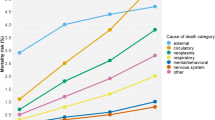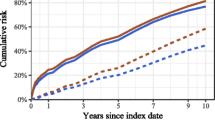Abstract
Summary
With an ageing population, the burden of hip fractures is expected to increase in the coming decades. Older individuals with hip fracture are more than 3.5 times more likely to die within 12 months compared to non-injured individuals. The main priority for reducing mortality should be prevention of hip fracture.
Purpose
The aim of this study is to quantify and describe the 12-month mortality of older persons presenting to hospitals in Australia with a hip fracture.
Methods
Population-based matched cohort study using linked hospital and mortality data from four Australian states (New South Wales, Queensland, South Australia, and Tasmania). Individuals aged 65 years and older who had a hospital admission with a primary diagnosis of hip fracture in 2009 (n = 9748) and a matched comparison cohort of non-injured individual were selected from the electoral roll (n = 9748). The comparison group was matched 1:1 on age, sex, and postcode of residence. Adjusted mortality rate ratios (MRR) and attributable risk percent were calculated. Cox proportional hazard regression was used to examine the effect of risk factors on survival.
Results
The hip fracture cohort experienced significantly worse survival at the 12-month post-fracture hospitalisation (P < 0.0001). Individuals with hip fracture were more than 3.5 times more likely to die within 12 months compared to their non-injured counterparts (MRR 3.62 [95%CI 3.23–4.05]). Hip fracture was likely to be a contributory factor in 72% of mortality within 12 months after the index hospital admission. Excess mortality risk at 12 months was higher in males than that in females and in the 65–74-year age group.
Conclusions
With an ageing population in Australia, the burden of hip fractures is expected to increase in the coming decades. Because incident hip fracture is the main predictor of subsequent mortality, the main priority for reducing excess mortality after hip fracture is primary and secondary prevention of hip fracture.



Similar content being viewed by others
References
Johnell O, Kanis JA (2004) An estimate of the worldwide prevalence, mortality and disability associated with hip fracture. Osteoporos Int 15:897–902
Kanis JA, Oden A, EV MC, Johansson H, Wahl DA, Cooper C, IOF Working Group on Epidemiology and Quality of Life (2012) A systematic review of hip fracture incidence and probability of fracture worldwide. Osteoporos Int 23:2239–2256
Haentjens P, Magaziner J, Colon-Emeric CS, Vanderschueren D, Milisen K, Velkeniers B, Boonen S (2010) Meta-analysis: excess mortality after hip fracture among older women and men. Ann Intern Med 152:380–390
Katsoulis M, Benetou V, Karapetyan T, Feskanich D, Grodstein F, Pettersson-Kymmer U, Eriksson S, Wilsgaard T, Jørgensen L, Ahmed LA, Schöttker B, Brenner H, Bellavia A, Wolk A, Kubinova R, Stegeman B, Bobak M, Boffetta P, Trichopoulou A (2017) Excess mortality after hip fracture in elderly persons from Europe and the USA: the CHANCES project. J Intern Med 281:300–310
Stephens AS, Toson B, Close JC (2014) Current and future burden of incident hip fractures in New South Wales, Australia. Arch Osteoporos 9:200
Budhia S, Mikyas Y, Tang M, Badamgarav E (2012) Osteoporotic fractures: a systematic review of U.S. healthcare costs and resource utilization. PharmacoEconomics 30:147–170
Haentjens P, Autier P, Barette M, Boonen S, Belgian Hip Fracture Study Group (2001) The economic cost of hip fractures among elderly women. A one-year, prospective, observational cohort study with matched-pair analysis. Belgian Hip Fracture Study Group. J Bone Joint Surg Am 83-A:493–500
Haentjens P, Lamraski G, Boonen S (2005) Costs and consequences of hip fracture occurrence in old age: an economic perspective. Disabil Rehabil 27:1129–1141
Braithwaite RS, Col NF, Wong JB (2003) Estimating hip fracture morbidity, mortality and costs. J Am Geriatr Soc 51:364–370
Nurmi I, Narinen A, Lüthje P, Tanninen S (2003) Cost analysis of hip fracture treatment among the elderly for the public health services: a 1-year prospective study in 106 consecutive patients. Arch Orthop Trauma Surg 123:551–554
Garcia AE, Bonnaig JV, Yoneda ZT, Richards JE, Ehrenfeld JM, Obremskey WT, Jahangir AA, Sethi MK (2012) Patient variables which may predict length of stay and hospital costs in elderly patients with hip fracture. J Orthop Trauma 26:620–623
Loures FB, Chaoubah A, Oliveira VM, Almeida AM, Campos EM, Paiva EP (2015) Economic analysis of surgical treatment of hip fracture in older adults. Rev Saude Publica 49:12
Petersen MB, Jorgensen HL, Hansen K, Duus BR (2006) Factors affecting postoperative mortality of patients with displaced femoral neck fracture. Injury 37:705–711
Richmond J, Aharonoff GB, Zuckerman JD, Koval KJ (2003) Mortality risk after hip fracture. J Orthop Trauma 17:53–56
Aharonoff GB, Koval KJ, Skovron ML, Zuckerman JD (1997) Hip fractures in the elderly: predictors of one year mortality. J Orthop Trauma 11:162–165
Berggren M, Stenvall M, Englund U, Olofsson B, Gustafson Y (2016) Co-morbidities, complications and causes of death among people with femoral neck fracture—a three-year follow-up study. BMC Geriatr 16:120
Roche JJW (2015) Effect of comorbidities and postoperative complications on mortality after hip fracture in elderly people: prospective observational cohort study. BMJ 331:1374
Tosteson AN, Gottlieb DJ, Radley DC, Fisher ES, Melton LJ 3rd (2007) Excess mortality following hip fracture: the role of underlying health status. Osteoporos Int 18:1463–1472
Clayer MT, Bauze RJ (1989) Morbidity and mortality following fractures of the femoral neck and trochanteric region: analysis of risk factors. J Trauma 29:1673–1678
Todd CJ, Freeman CJ, Camilleri-Ferrante C, Palmer CR, Hyder A, Laxton CE, Parker MJ, Payne BV, Rushton N (1995) Differences in mortality after fracture of hip: the East Anglian audit. BMJ 310:904–908
Wehren LE, Hawkes WG, Orwig DL, Hebel JR, Zimmerman SI, Magaziner J (2003) Gender differences in mortality after hip fracture: the role of infection. J Bone Miner Res 18:2231–2237
Roberts SE, Goldacre MJ (2003) Time trends and demography of mortality after fractured neck of femur in an English population, 1968–98: database study. BMJ 327:771–775
Castronuovo E, Pezzotti P, Franzo A, Di Lallo D, Guasticchi G (2011) Early and late mortality in elderly patients after hip fracture: a cohort study using administrative health databases in the Lazio region, Italy. BMC Geriatr 11:37
Franzo A, Francescutti C, Simon G (2005) Risk factors correlated with post-operative mortality for hip fracture surgery in the elderly: a population-based approach. Eur J Epidemiol 20:985–991
Abrahamsen B, van Staa T, Ariely R, Olson M, Cooper C (2009) Excess mortality following hip fracture: a systematic epidemiological review. Osteoporos Int 20:1633–1650
Mitchell R, Cameron C, McClure R (2016) Quantifying the morbidity and mortality attributable to traumatic injury using a population-based matched cohort in Australia. BMJ Open 6:e013266
National Centre for Classification in Health (2006) ICD-10-AM, 5th edn. National Centre for Classification in Health, Sydney
Quan H, Li B, Couris C, Fushimi K, Graham P, Hider P, Januel JM, Sundararajan V (2011) Updating and validating the Charlson comorbidity index and score for risk adjustment in hospital discharge abstracts using data from 6 countries. Am J Epidemiol 173:676–682
Miller T, Lestina D, Smith GS (2001) Injury risk among medically identified alcohol and drug abusers. Alcohol Clin Exp Res 25:54–59
Wan J, Morabito D, Khaw L, Knudson MM, Dicker RA (2006) Mental illness as an independent risk factor for unintentional injury and injury recidivism. J Trauma Acute Care Surg 61:1299–1304
Australian Bureau of Statistics (2013) 1270.0.55.005—Australian Statistical Geography Standard (ASGS): Volume 5—remoteness structure, July 2011. Australian Bureau of Statistics, Canberra [updated 23/07/2014] Available from: http://www.abs.gov.au/AUSSTATS/abs@.nsf/ DetailsPage/1270.0.55.005July%202011?OpenDocument
Pearce N (2016) Analysis of matched case-control studies. BMJ 352:i969
Woodward M (2005) Epidemiology: study design and analysis, 2nd edn. Chapman & Hall CRC, Boca Raton
Poor G, Atkinson EJ, O'Fallon WM, Melton LJ 3rd (1995) Determinants of reduced survival following hip fractures in men. Clin Orthop Relat Res 319:260–265
Klop C, Welsing P, Cooper C, Harvey NC, Elders PJ, Bijlsma JW, Leufkens HG, de Vries F (2014) Mortality in British hip fracture patients, 2000–2010: a population-based retrospective cohort study. Bone 66:171–177
Jiang HX, Majumdar SR, Dick DA, Moreau M, Raso J, Otto DD, Johnston DW (2005) Development and initial validation of a risk score for predicting in-hospital and 1-year mortality in patients with hip fractures. J Bone Miner Res 20:494–500
Vestergaard P, Rejnmark L, Mosekilde L (2007) Increased mortality in patients with a hip fracture-effect of pre-morbid conditions and post-fracture complications. Osteoporos Int 18:1583–1593
Endo Y, Aharonoff GB, Zuckerman JD, Egol KA, Koval KJ (2005) Gender differences in patients with hip fracture: a greater risk of morbidity and mortality in men. J Orthop Trauma 19:29–35
Holt G, Smith R, Duncan K, Hutchison JD, Gregori A (2008) Gender differences in epidemiology and outcome after hip fracture: evidence from the Scottish Hip Fracture Audit. J Bone Joint Surg Br 90:480–483
Australian Institute of Health and Welfare (2015) Admitted patient care 2013–14. Australian Institute of Health and Welfare, Canberra
Centre NCG (2011) The management of hip fracture in adults. National Clinical Guideline Centre, London
Australian and New Zealand Hip Fracture Registry Steering Group (2014) Australian and New Zealand guideline for hip fracture care: improving outcomes in hip fracture management of adults. Australian and New Zealand Hip Fracture Registry Steering Group, Sydney
Mitchell R, Cameron C, Bambach M (2014) Data linkage for injury surveillance and research in Australia: perils, pitfalls and potential. Aust N Z J Public Health 38:276–281
Preen D, Holman CD, Spilsbury K, Semmens JB, Brameld KJ (2006) Length of comorbidity lookback period affected regression model performance of administrative health data. J Clin Epidemiol 59:940–946
Acknowledgements
The authors wish to thank the New South Wales Ministry of Health, Queensland Department of Health, South Australia Department for Health and Ageing, and Tasmania Department of Health and Human Services for providing access to their emergency department presentation and admitted patient data collections; the New South Wales, Queensland, South Australian, and Tasmanian Registries of Births, Deaths and Marriages for providing access to mortality data; and the New South Wales, Queensland, South Australian, and Tasmanian electoral commissions for providing access to their electoral rolls. The authors would also like to thank the Centre for Health Record Linkage (CHeReL), the Statistical Services Branch of the Queensland Department of Health, SA-NT DataLink, the Tasmanian Data Linkage Unit, and the Centre for Data Linkage for conducting the record linkage.
Author information
Authors and Affiliations
Contributions
RPL, CC, and RM were involved in study concept and design. RM acquired the data. RPL conducted the analysis and wrote the first draft of the manuscript. RPL, CC, and RM were all involved in interpretation of data and critical revision of the manuscript.
Corresponding author
Ethics declarations
Ethical approval was obtained from human research ethics committees associated with the Health Departments in each of the four states.
Funding sources
The research was supported by the Population Health Research Network with funding from the Australian Government National Collaborative Research Infrastructure Strategy and the Western Australian Minister for Science and Innovation. RM was supported by a career fellowship from the New South Wales Ministry of Health under the New South Wales Health Early-Mid Career Fellowships Scheme. The funding sources had no role in study design; acquisition, analysis, or interpretation of data; or preparation of manuscript.
Conflicts of interest
None.
Electronic supplementary material
Supplementary Table 1
(DOCX 30 kb)
Rights and permissions
About this article
Cite this article
Lystad, R.P., Cameron, C.M. & Mitchell, R.J. Mortality risk among older Australians hospitalised with hip fracture: a population-based matched cohort study. Arch Osteoporos 12, 67 (2017). https://doi.org/10.1007/s11657-017-0359-7
Received:
Accepted:
Published:
DOI: https://doi.org/10.1007/s11657-017-0359-7




